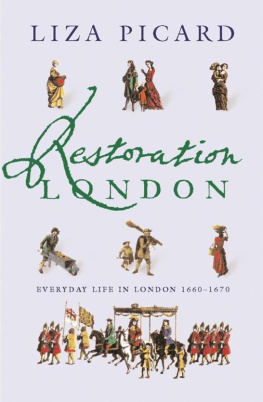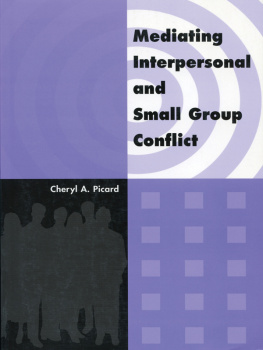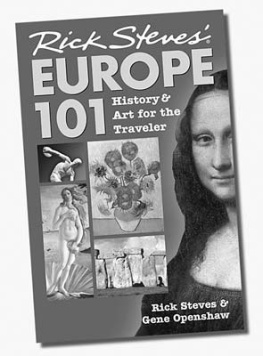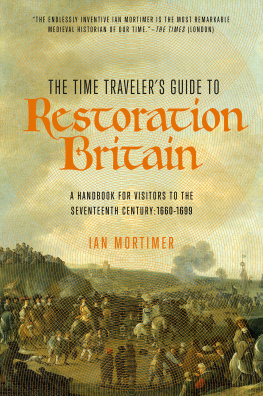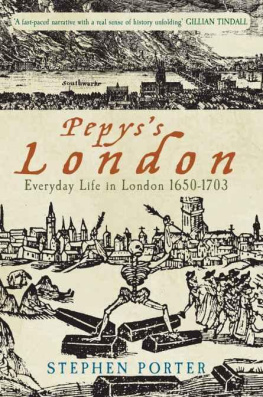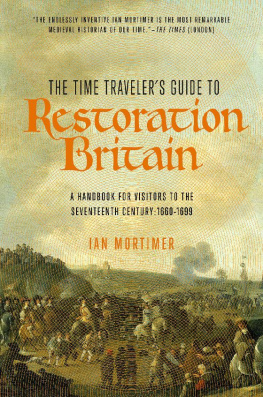
The author and publisher have provided this e-book to you for your personal use only. You may not make this e-book publicly available in any way. Copyright infringement is against the law. If you believe the copy of this e-book you are reading infringes on the authors copyright, please notify the publisher at: us.macmillanusa.com/piracy .
CONTENTS
FOREWORD
Indeed many excellent authors there be who have wrote excellent well of some particular subjects herein treated of. But there is not one of them hath written upon all of them. Hannah Wolley, Guide to the Female Sex (1682)
I have a practical mind. I have always been interested in how people lived. The practical details are rarely covered in social history books. Perhaps I lack some secret ability that would enliven such books for me; as it is, I have nearly always found them disappointing. The only answer appeared to be to write a book myself.
I am not a historian. I am a lawyer. I have a liking for primary evidence not what someone wrote long afterwards, or what someone has concluded from a selection of documents that I have not seen, but what someone said who was there at the time. This has led me down interesting detours, while I reinvented the wheel, and read as many contemporary documents as I could find. It perhaps wasted a lot of time; but it served as an enjoyable apprenticeship.
I had to set myself definite limits, in time and in place, if I were to avoid anodyne generalisations. Samuel Pepys provided my limits: the time (166070) and the place (London) covered by his Diary. (His Diary ends in May 1669; I have finished the decade without him.) I have allowed myself some latitude in time, where slightly later sources appear to relate equally to earlier times, or earlier sources record things which probably continued unchanged; and in place, where things of the right period have survived outside London. On some subjects, the Diary provides an incomparable record. I got to know it so well that I fell into the habit of referring to Mr and Mrs Pepys as Samuel and Elizabeth. I trust the reader will not think this an undue familiarity. References to the Diary are to the edition edited by Robert Latham and William Matthews, published in eleven volumes by Bell and Hyman, 197083.
Hannah Wolley was a redoubtable woman who published a variety of conduct books in the period; a seventeenth-century Mrs Beeton, dealing not merely with how to cook, but how to run a household. In our day, she would have run anything in sight, with charm and efficiency.
An unexpected mine of information was a man, Randle Holme, who set himself the task of describing everything used in heraldry. His three (part of another exists in manuscript) huge tomes, The Academy of Armory, were not published until 1688, but he had been writing them for years, certainly during the period I have chosen. His method was to list, in more or less alphabetical order, every relevant object, linking it to the relevant surname by the formula (taking an example at random): He beareth sable a Chamber pot or a bed pot argent Chamberley or Potts.
He gives detailed descriptions of mens and womens tailoring, as well as furniture and household equipment, and in case there should be any doubt in his readers mind as to what each item looked like, there are pages of thumbnail-sized drawings, some of which unfortunately have suffered with time. I was able to read his books in the British Library and the Bodleian Library, except for volume IV, which the Royal Librarian in Windsor Castle kindly allowed me to see.
Nicholas Culpeper was another vivid person in whose writings I immersed myself. He was born in London in 1616, the son of a non-conformist clergyman. He went to Cambridge for a short time when he was eighteen, and was possibly apprenticed to an apothecary. At twenty-four he set himself up as an Astrologer and physician, in Spitalfields. He fought on the Parliamentarian side in the Civil War, and was wounded. Perhaps it was while he recovered that he translated the Pharmacopaeia used by all physicians, from Latin into English, thereby making it directly available to the average literate man and incurring the wrath of the medical establishment of the time. His style, exemplified in the many books he found time to write, is gentle and paternal. He was concerned to see that the poor, so often ignored in those days, could have some basic kind of medical care, even if it was only self-medication using the herbs that grew wild, instead of costly ingredients recommended by his colleagues. He sounds like the kind of family doctor one would like to have.
It was hard to tear myself away from the beautiful flower books of the time, and books of garden advice.
John Evelyn is underrated. He cared passionately about London, and often wrote about it. His Diary tends to name-drop, but his description of the Fire, for example, is more evocative than Samuels, which is more often quoted. In contrast to Evelyns elegance is splendidly eccentric John Aubrey. Aubrey was born in 1626, the son of an impecunious Wiltshire squire. Like Culpeper his education was interrupted by the Civil War, but unlike Culpeper he never really worked thereafter. His debts overtook him, and an effort to solve his problem in the obvious way by marrying an heiress merely landed him in more trouble. He must have been a delightful man to have in the house, because he spent the rest of his life living with, and on, his friends, and following his antiquarian hobby. He died in 1697. His closest friend described him as shiftless roving and maggotty-headed, yet was devoted to him. That friend, another of my sources, was Anthony Wood, as he liked to style himself, scribbling away peevishly in Oxford, where his quiet academic life was disrupted by the periodic incursions of the Court.
A fascinating contemporary source is the Calendar of State Papers Domestic. This is a rag-bag of papers about matters which nowadays would fit roughly into the spheres of the Home Office, the Department of Social Security and the Ministry of Defence, with some spice from current scandals. It stretches from a 3 reward offered for some strayed cows in Ashdown Forest, to the several millions voted for the Navy. Much of it, indeed, refers to the Navy: anguished letters from ships captains to Sam. Pepys, asking for supplies of everything from men and masts to beer. The entries are not always clearly dated except by year. The reiteration of CSPD in the notes indicates the many hours I spent reading the Calendar in the Bodleian Library, sometimes cross-eyed at the end of the day because the entries are not effectively indexed.
Then I settled down to the statutes passed between 1660 and 1670; and a great deal easier to read they were, than modern statutes. The draftsmen had not discovered the magic device of the schedule, nor had they yet become adept in the double negative qualified by exceptions to be read in conjunction with later inconsistent sections. Of course, the passing of a law has never meant that its provisions were observed from then on. If this happy state of affairs applied, the restrictions on urban development passed in the fourteenth century need never have been, as they were, reiterated by every successive administration. But the very frequency of statutes dealing with the same problem shows, at least, the urgency of the problem. And the preambles or explanations, which tend to be scattered through each Act instead of in one lump at the beginning as now, provide a fascinating picture of the situation which the legislators were trying to cure. To a lawyer, preambles are not part of the Act, and can be ignored. To a historian, I suggest they are worth more than the substantive sections, since they are likely to be true.
Next page
